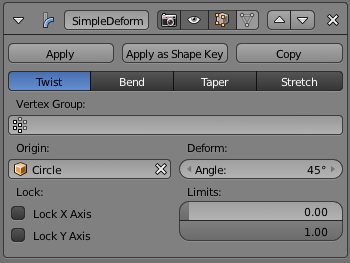Simple Deform Modifier¶
The Simple Deform Modifier allows easy application of a simple deformation to an object (meshes, lattices, curves, surfaces and texts are supported).
Using another object, it is possible to define the axis and origin of the deformation, allowing application of very different effects.
Options¶

Simple Deform.
- Mode
This radio button defines the deform function applied, among four available:
- Twist
- Rotates around the Z axis.
- Bend
- Bends the mesh over the Z axis.
- Taper
- Linearly scales along Z axis.
- Stretch
- Stretches the object along the Z axis (negative Factor leads to squash), preserving volume by scaling inversely on the X and Y axes.
- Vertex Group
- The name of the vertex group that indicates whether and how much each vertex is influenced by the deformation.
- Origin
The name of an object that defines the origin of deformation (usually an empty). This object can be:
- Rotated to control the axis (its local Z-axis is now used as the deformation axis).
- Translated to control the origin of deformation.
- Scaled to change the deform factor.
Note
When the object controlling the origin (the one in the Origin field) is a child of the deformed object, this creates a cyclic dependency in Blender’s data system. The workaround is to create a new empty and parent both objects to it.
- Angle/Factor
- The amount of deformation. Can be negative to reverse the deformation.
- Limits
- These settings allow you to set the lower and upper limits of the deformation. The upper limit cannot be lower than lower limit.
- Lock X Axis / Lock Y Axis (Taper and Stretch modes only)
- These controls whether the X and/or Y coordinates are allowed to change or not. Thus it is possible to squash the X coordinates of an object and keep the Y coordinates intact.